Polymethyl methacrylate (PMMA) offers excellent transparency and high dielectric strength, making it suitable for electrical connectors requiring optical clarity and insulation. Polybutylene terephthalate (PBT) provides superior mechanical strength, chemical resistance, and flame retardancy, ideal for durable and heat-resistant electrical connectors.
Table of Comparison
| Property | Polymethyl Methacrylate (PMMA) | Polybutylene Terephthalate (PBT) |
|---|---|---|
| Material Type | Acrylic Thermoplastic | Engineering Thermoplastic Polyester |
| Mechanical Strength | Moderate Tensile Strength (40-70 MPa) | High Tensile Strength (50-85 MPa) |
| Thermal Resistance | Heat Deflection Temperature ~90degC | Heat Deflection Temperature ~120-150degC |
| Electrical Insulation | Good Insulator, Dielectric Strength ~15-20 kV/mm | Excellent Insulator, Dielectric Strength ~20-25 kV/mm |
| Chemical Resistance | Resistant to dilute acids & alkalis; poor resistance to solvents | High chemical resistance to oils, greases, and solvents |
| Moisture Absorption | Low (0.3-0.5%) | Moderate (0.2-1.2%) |
| Application Suitability | Transparent parts, low mechanical stress connectors | Durable, heat-resistant electrical connectors |
Introduction to Electrical Connectors
Electrical connectors require materials with excellent dielectric properties and mechanical stability to ensure reliable signal transmission and power delivery. Polymethyl methacrylate (PMMA) offers superior optical clarity and good electrical insulation, making it suitable for connectors in low-stress, visually sensitive applications. Polybutylene terephthalate (PBT) provides enhanced thermal resistance, chemical stability, and dimensional accuracy, making it the preferred choice for high-performance electrical connectors exposed to heat and mechanical wear.
Overview of Polymethyl Methacrylate (PMMA)
Polymethyl methacrylate (PMMA) is a transparent thermoplastic known for its excellent optical clarity, high tensile strength, and good electrical insulation properties, making it suitable for electrical connector components requiring visibility and dielectric reliability. PMMA offers superior weather resistance and UV stability compared to other plastics, contributing to its durability in outdoor and harsh environments. However, PMMA has lower chemical resistance and thermal stability than Polybutylene terephthalate (PBT), limiting its use in high-temperature or aggressive chemical conditions typical in some electrical connector applications.
Overview of Polybutylene Terephthalate (PBT)
Polybutylene terephthalate (PBT) is a thermoplastic polymer widely used for electrical connectors due to its excellent electrical insulation properties, high mechanical strength, and resistance to heat and chemicals. Compared to polymethyl methacrylate (PMMA), PBT offers superior dimensional stability, improved impact resistance, and better resistance to moisture absorption, making it ideal for harsh environments and demanding electrical applications. Its ability to withstand continuous operating temperatures up to 150degC and its low dielectric constant enhance connector performance in automotive and industrial electronics.
Mechanical Properties Comparison
Polymethyl methacrylate (PMMA) offers high tensile strength and excellent rigidity, with a tensile modulus around 2.5-3.3 GPa, making it suitable for electrical connectors requiring dimensional stability and resistance to deformation. Polybutylene terephthalate (PBT) exhibits superior impact resistance and greater flexibility, with tensile strength typically between 50-70 MPa and a tensile modulus around 2.0-2.7 GPa, which enhances durability under mechanical stress and vibration. PBT's enhanced toughness and resistance to fatigue often make it preferable for electrical connectors exposed to dynamic mechanical loads compared to the more brittle PMMA.
Electrical Insulation Capabilities
Polymethyl methacrylate (PMMA) offers excellent electrical insulation properties with a high dielectric strength typically around 20-25 kV/mm, making it suitable for applications requiring superior insulation and optical clarity. Polybutylene terephthalate (PBT) exhibits strong electrical insulation characteristics combined with high thermal resistance and dimensional stability, often used in electrical connectors exposed to higher temperatures up to 120-150degC. While PMMA excels in dielectric performance, PBT provides a balanced combination of electrical insulation and mechanical robustness ideal for durable connector environments.
Thermal Performance and Stability
Polymethyl methacrylate (PMMA) exhibits lower thermal resistance with a maximum service temperature around 100degC, making it less suitable for high-heat electrical connector applications compared to polybutylene terephthalate (PBT), which withstands continuous use up to 150degC. PBT offers superior dimensional stability and maintains mechanical properties under thermal stress, resulting in enhanced reliability for electrical connectors exposed to elevated temperatures. The inherent flame-retardant properties and lower moisture absorption of PBT further contribute to its thermal performance and long-term stability in electrical environments.
Chemical Resistance and Durability
Polymethyl methacrylate (PMMA) offers excellent chemical resistance against acids and alkalis but has limited durability under mechanical stress and high temperatures compared to Polybutylene terephthalate (PBT). PBT exhibits superior chemical resistance to solvents, hydrocarbons, and oils, alongside enhanced thermal stability and mechanical strength, making it more suitable for demanding electrical connector applications. The durability of PBT ensures longer service life in harsh environments, whereas PMMA is better suited for applications where transparency and moderate resistance are prioritized.
Cost-Effectiveness and Material Availability
Polymethyl methacrylate (PMMA) offers higher transparency and ease of processing, making it a cost-effective choice for electrical connectors requiring visual inspection, while its widespread availability ensures consistent supply. Polybutylene terephthalate (PBT) provides superior mechanical strength and excellent chemical resistance, but typically comes at a higher material cost and may have more limited availability depending on regional suppliers. Evaluating connector performance requirements alongside budget constraints often guides the selection between cost-efficient PMMA and durable PBT options.
Applications in Electrical Connector Manufacturing
Polymethyl methacrylate (PMMA) offers excellent electrical insulation and optical clarity, making it ideal for transparent electrical connector components requiring high dielectric strength and resistance to UV degradation. Polybutylene terephthalate (PBT) provides superior mechanical toughness, chemical resistance, and dimensional stability at elevated temperatures, which is crucial for manufacturing robust, heat-resistant electrical connectors in automotive and industrial applications. The choice between PMMA and PBT in electrical connector manufacturing depends on the specific requirements for transparency, thermal performance, and mechanical durability.
Summary: Choosing Between PMMA and PBT
Polymethyl methacrylate (PMMA) offers excellent transparency and electrical insulation but has lower thermal resistance compared to polybutylene terephthalate (PBT), which provides superior mechanical strength and higher heat resistance, making it more suitable for high-temperature electrical connector applications. PBT's superior chemical resistance and dimensional stability under stress enhance connector durability in harsh environments. When selecting between PMMA and PBT, consider the application's thermal demands and mechanical load requirements to ensure optimal performance and longevity.

Infographic: Polymethyl methacrylate vs Polybutylene terephthalate for Electrical connector
 azmater.com
azmater.com